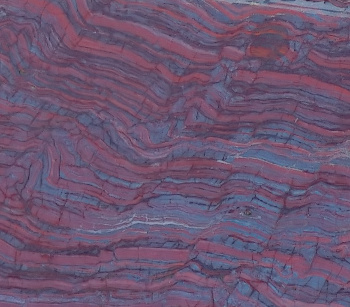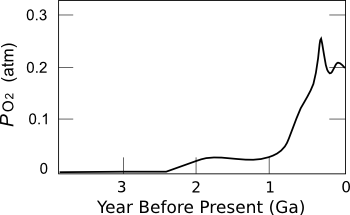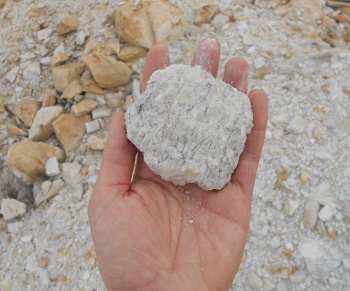Early Oxygen
September 17, 2014
We owe our
oxygen-
fueled existence to
Earth's many
photosynthetic plants and
bacteria. Oxygen exists presently in
Earth's atmosphere at a
partial pressure of about 0.21
atmospheres, but there was a time when the pressure was nearly zero. It's understandable that
scientists are interested in when our atmosphere started to become oxygen-enriched, since that would mark the time when such
life first evolved on our
planet. The history of Earth's oxygen is contained in its
geological record.
As I wrote in a
previous article (Ordovician Carbon Sinks, February 28, 2012), oxygen-producing
organisms weren't present on
land until about 450
million years ago, during the
Ordovician period. These early land plants were primitive,
non-vascular mosses. They likely evolved from
green algae in the
oceans, but the oceans were teeming with oxygen-producing
prokaryote cyanobacteria long before then.
Cyanobacteria are thought to have appeared about 2.5
billion years ago, but the oxygen that they produced
chemically combined with
iron and
organic compounds. Since the seas that time were
acidic, there would have been large quantities of
dissolved iron, and some
nickel. Oxygen produced by the cyanobacteria would have combined with iron to form
iron oxide. One
record of this is the appearance of
iron bands in
Archean sedimentary rocks (see photograph).

A black-banded ironstone, about 2.1 billion years old, at the National Museum of Mineralogy and Geology in Dresden, Germany.
Iron oxide was precipitated in the oceans until the dissolved iron was gone.
(Detail of a photo by André Karwath, via Wikimedia Commons.)
When such oceanic oxygen sinks became depleted, oxygen appeared in Earth's atmosphere in the aptly-termed
Great Oxygenation Event, about 2.3 billion years ago (see figure). All this oxygen remade Earth's
crust by producing a
diversity of minerals. These
minerals were
hydrates and
oxides that couldn't form without sufficient oxygen, and the Great Oxygenation Event doubled the number of mineral types on Earth. Interestingly, oxygen
concentration was much higher about 300 million years ago, at the end of the
Carboniferous period, than today. The partial pressure of oxygen may have been as high as 0.35 atmospheres at that time.

Estimated oxygen content of Earth's atmosphere over the ages.
Earth's oxygen partial pressure is now about 0.21 atmospheres.
(Figure by Heinrich D. Holland, modified, via Wikimedia Commons.)
Now, a team of
geologists from the
Presidency University (Kolkata, India), the
Indian Atomic Minerals Directorate (Jharkhand, India), and
Trinity College Dublin (Dublin, Ireland) have found evidence that there was a
transient atmospheric oxygenation event that occurred at least 600 million years before the Great Oxygenation Event, and about 60 million years before a previously documented Archean oxygenation event. Not only that, but they propose that there were several such short oxygenation events prior to the Great Oxygenation Event.[1-2]
For this to have happened, oxygen-producing life forms must have been present 60 million years earlier than previously thought.[2] The
evidence is
chemical weathering of
rocks caused by oxygen that produced ancient
soil called
palaeosol. Such soil was found near the town of
Keonjhar, in the
Singhbhum Craton of
Odisha.[1-2]
Quentin Crowley,
Assistant Professor and Ussher Lecturer at Trinity and senior
author of the
paper in
Geology that describes this
research, says
"This is a very exciting finding, which helps to fill a gap in our knowledge about the evolution of the early Earth. This paleosol from India is telling us that there was a short-lived pulse of atmospheric oxygenation and this occurred considerably earlier than previously envisaged."[2]

A hand sample of 3.02 billion year old palaeosol, formed long before the Great Oxygenation Event.
(Photograph by Quentin Crowley.)[2)]
Very few of these paleosols have an age prior to 2.5 billion years ago. To date the soil, the geologists used
uranium-lead isotope dating of contained
zircons.[1] They found that the Paleosols were at least 3.02 billion years old, and they may be as old as 3.29 billion years.[1-2] There is also some evidence from
South African paleosols of increased atmospheric oxygen about 2.96 billion years.[2]
References:
- Joydip Mukhopadhyay, Quentin G. Crowley, Sampa Ghosh, Gautam Ghosh, Kalyan Chakrabarti, Brundaban Misra, Kyle Heron, and Sankar Bose, "Oxygenation of the Archean atmosphere: New paleosol constraints from eastern India," Geology, vol. 42, no. 10 (October 2014), pp. 1–4.
- Trinity geologists re-write Earth's evolutionary history books, Trinity College Dublin Press Release, September 4, 2014.
Permanent Link to this article
Linked Keywords: Oxygen; fuel; existence; Earth; photosynthesis; photosynthetic; plant; bacteria; atmosphere of Earth; atmosphere; partial pressure; scientist; life; planet; geological history of oxygen; geological record; organism; continent; land; year; Ordovician period; vascular plant; moss; green algae; ocean; prokaryote; cyanobacteria; chemical reaction; chemically combined; iron; organic compound; acid; acidic; dissolution; dissolve; nickel; iron oxide; banded iron formation; iron band; Archean; sedimentary rock; ironstone; Dresden, Germany; precipitation; precipitate; Wikimedia Commons; Great Oxygenation Event; crust; mineral diversification; mineral; hydrate; oxide mineral; oxide; concentration; Carboniferous; geologist; Presidency University (Kolkata, India); Atomic Minerals Directorate for Exploration and Research; Indian Atomic Minerals Directorate (Jharkhand, India); Trinity College Dublin (Dublin, Ireland); transient state; transient; atmospheric; oxygenation; evidence; chemical weathering; rock; soil; palaeosol; Kendujhar; Keonjhar; Singhbhum; Craton; Odisha; Quentin Crowley; Assistant Professor; author; academic publishing; paper; Geology; research; radiometric dating; Uranium-lead dating method; uranium-lead isotope dating; zircon; South Africa.